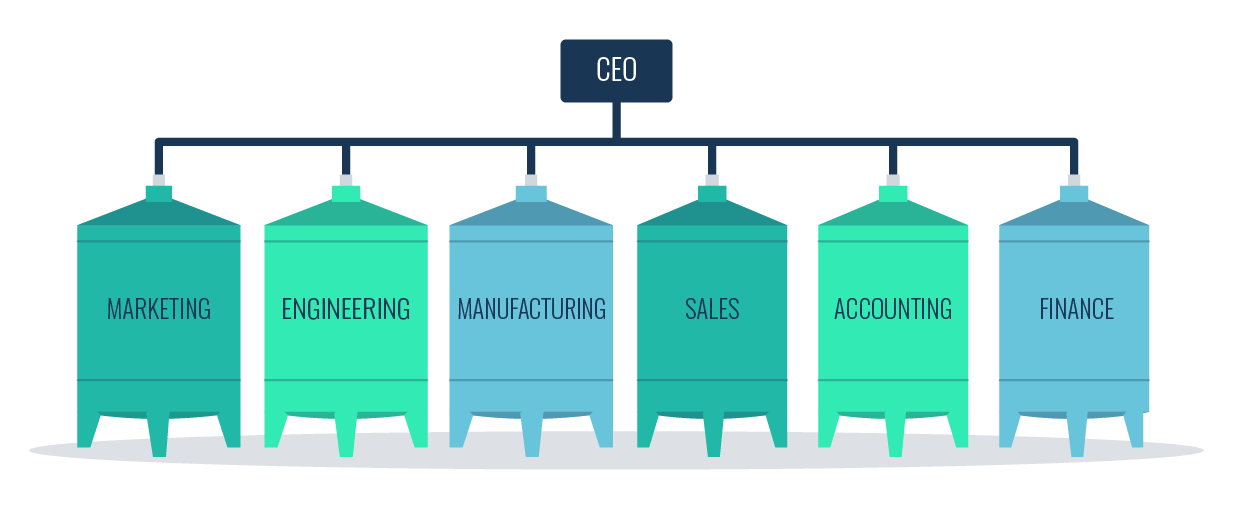
Ever found out too late that a coworker had the exact expertise you needed? Or discovered that another team already solved a problem you’ve been struggling with? Has, ‘wait, nobody told me that!’ become your new official catchphrase?
If you recognise these symptoms, then your workplace likely suffers from knowledge silos. This means that critical information is trapped within teams, departments, or even individual minds. And it’s a surprisingly common phenomenon.
Indeed, 79% of employees agree that information is siloed throughout their organisation. And 68% report negative consequences as a result.
Breaking down silos enables a healthy flow of information, which fuels innovation. As the American novelist Louis L’Amour observed, ‘Knowledge is like money: To be of value it must circulate, and in circulating it can increase in quantity, and hopefully, in value’.
In this article, we’ll define knowledge silos and silo mindsets, expose the harm they cause, and provide some top tips for removing these systemic obstacles. Ready? Then it’s time to break free!
What is a Knowledge Silo?
A knowledge silo, or information silo, forms when individuals or teams within an organisation possess valuable information, expertise, or skills that are not shared with others who could put them to good use.
To help illustrate this idea, think of individual grain silos, each holding a potentially bountiful harvest. They stand tall and self-contained. However, they are sealed off from each other and never connect.

As the originator of this concept, Phil Ensor, puts it: “Communication is heavily top-down, on the vertical axis. Little is shared on the horizontal axis.”
Management guru Peter Senge deployed a similarly powerful image in his seminal work, The Fifth Discipline, describing organisational ‘stovepipes’. Just like smoke trapped in one of these chimneys, knowledge shoots upwards but never spreads sideways, resulting in ‘fundamental learning disabilities’.
Let’s illustrate this further with a few painful examples. Try not to wince:
- Team A spends weeks cracking a problem that Team B solved months ago (but never bothered to tell anyone).
- Clive from Accounting is the only one who knows how the budget spreadsheet works (but he’s away on annual leave).
- A group of new hires waste time searching for information (that should be in a company handbook or onboarding module).
How do Knowledge Silos Form?
Okay, so now we’ve defined knowledge silos and established that they’re less than ideal. But how do these divisions actually arise? Here are a few telltale signs that knowledge silos may be lurking within your organisation:
- Departmental Drawbacks: Organisations are typically structured into departments so they can have their own specific areas of responsibility and focus. While this boosts efficiency, it also creates invisible walls between teams. Ever heard Sales grumble about Marketing ‘never giving them what they need’? You’re not alone!
- Communication Challenges: Silos naturally form when teams don’t have easy ways to share information. Without shared platforms, cross-team meetings, internal wikis, or documented processes, critical information stays trapped in its own little bubble. It’s like having a group chat where only a fraction of your organisation is invited.
- Culture Constraints: Some organisations inadvertently promote a ‘star player’ culture, where individual wins overshadow collaborative results. This is an anathema for teamwork. Instead, you end up breeding intellectual mercenaries who hoard their knowledge to help inflate their personal worth.
- Onboarding Obstacles: Your new hires are particularly vulnerable. Without immediate access to the information they need, they risk becoming isolated within their own silo from the very beginning. This highlights the importance of a strong employee onboarding programme. It’s your first line of defence against organisational fragmentation.
- Mentality Missteps: Misguided mindsets are a fertile ground for knowledge silos. Phrases like ‘it’s faster if I just do it myself’ or ‘that’s how we’ve always done it’, are fragmentation red flags. After all, resistance to change and a short-term focus nurture negative impulses that block the vital exchange of information.
What is a Silo Mentality?
That last point leads us neatly onto the related idea of a ‘silo mentality’. This is a mindset where individuals or teams hoard knowledge and are reluctant (for whatever reason) to share it with the wider organisation.
This reluctance to share doesn’t arise in a vacuum. It’s often a manifestation of top-down issues or a broader cultural problem that permeates throughout your organisation. Specifically, it often stems from these underlying psychological factors:
- Job Security: The adage ‘knowledge is power’ has a particularly sharp edge in the workplace, where peoples’ livelihoods are at stake. Unfortunately, this can lead to employees stockpiling information in order to make themselves indispensable and less likely to be replaced.
- Trust Issues: We tend to confide in those we trust. In turn, when our trust is broken or there’s a fear of repercussions, people tend to withhold knowledge. For example, a sales team may stop providing customer feedback to product development if they believe their input won’t be valued or properly used.
- Communication Styles: The way we communicate with each other also plays a key role in knowledge transfer. For example, introverted individuals may be less likely to proactively share their knowledge. What’s more, different communication styles can lead to misunderstandings and barriers to meaningful connection.
- Time Constraints: Let’s not forget that in most modern workplaces, your employees are often overloaded. This may cause them to prioritise immediate tasks over any potential knowledge sharing activities. Take, for instance, a developer rushing to meet sprint goals and skipping crucial code documentation.
What Impact do Knowledge Silos Have?
When getting to important information feels like the world’s least exciting treasure hunt, efficiency plummets and frustration mounts. This breakdown in communication has a real impact on your organisation’s performance.
According to Gartner, 47% of workers struggle to find the information they need to complete their jobs. Indeed, this constant search costs each employee a whopping 11.6 hours per week. The impact of these inefficiencies is underscored by a recent Atlassian report, which found that:
- A worrying 56% of staff believe that the only path to information is a direct ask or a scheduled meeting.
- 50% (that’s one in every two employees!) have witnessed separate teams unknowingly working on the same tasks.
- And 43% of employees agree they’d be faster if finding information wasn’t so difficult and time-consuming.
Without readily available information, your organisation’s leaders and employees are ill-equipped to make sound decisions. It’s like attempting to play pin the tail on the donkey after being blindfolded, spun dizzy, and dropped in a random place.
When knowledge silos meet the forgetting curve and employee attrition, the result is a dangerous erosion of your intellectual capital. Don’t let it happen. In the next section, we’ll explore some practical steps for ensuring that knowledge flows effortlessly throughout your organisation.
Knowledge Silos: How to Break Down the Walls

Once formed, your knowledge silos won’t disappear on their own. Instead, you’ll need to take deliberate action. With this in mind, here’s our step-by-step guide to dismantling these partitions and fostering a culture where collaboration thrives:
- Create a Knowledge Sharing Culture: Knowledge silos wont survive in an environment where sharing is the norm, rather than the exception. Consider launching cross-functional ‘silo-smashing’ teams for key projects, knowledge exchange sessions, and make sure you recognise the right team-based behaviours (more on this shortly).
- Focus on Shared Goals: One of the root causes of knowledge silos is teams working towards independent objectives. By contrast, shared goals create a common purpose and natural incentives for collaboration and information flow. For instance, instead of separate marketing and sales targets, you could implement a single revenue goal that unites both teams.
- Get Your Onboarding Right: Poor onboarding hinders your new employees and plants the seeds for future knowledge silos. By providing a thorough induction programme and easy access to necessary information from the start, you prevent isolation. You could even consider pairing them with a peer from another department.
- Encourage Job Shadowing: To cultivate inter-departmental understanding and stronger connections, make job shadowing across different roles a regular opportunity. Similarly, you should seek to combine teams in training sessions and mentoring opportunities to help dissolve artificial functional boundaries.
- Reward The Right Things: What gets celebrated gets repeated. If your recognition mechanisms are primarily highlighting individual achievements, then you’ll actively encourage silos. On the other hand, if you tie your reward system (performance reviews, promotions, bonuses, etc.) to collaborative metrics, you’ll soon shift the scale. Publicly acknowledging knowledge-sharing wins in company-wide communications will further reinforce this shift.
- Lead by Example: Finally, don’t forget to act as a standard bearer. After all, culture flows downhill. If your leadership team hoards information, or tolerates similar behaviour, then your employees will follow suit. Conversely, when your leaders publicly acknowledge their knowledge gaps and actively seek input, it sends a powerful message.
Tech-Powered Knowledge Flow
Ultimately, the true antidote to knowledge silos is a central, easily navigable space where information resides. Forget the image of separate silos. Instead, envision a vibrant, interconnected system where information can be exchanged with ease.
Technology can help you bring this vision to life. Encouragingly, the majority of large companies have a system in place to share information. Unfortunately, these platforms are only used by 45% of employees.
This low adoption rate is a shame, especially since McKinsey suggests that these systems can save your team as much as 35% of their time.
For instance, you could consider implementing knowledge management systems (KMS) such as Confluence, SharePoint, Notion and so on. To help stay connected, you will also benefit from tools like Slack, Microsoft Teams, and Zoom.
Our main recommendation, however, is to consider introducing a learning management system (LMS). These platforms provide a central hub for learning content, ensuring consistent training and effective knowledge sharing throughout your organisation.
Key Features for Knowledge Sharing
Implementing a knowledge-sharing platform is just the first step. To truly unlock its potential, you’ll need engaged and motivated learners. With this in mind, here are three key features that can help you to unlock organisational knowledge:
- Social Features: Many modern learning platforms come equipped with built-in social and collaboration tools designed to dismantle communication barriers. This includes, for example, discussion forums, instant messaging, user profiles, dedicated ‘Experts Areas’, and more. As a result, you’ll organically build communities of practice that enable effortless knowledge exchange.
- Gamification: Likewise, forward-thinking learning systems also strategically employ game mechanics to turbocharge learner engagement. Game elements can include experience points, digital badges, friendly leaderboards, knowledge contests, and more. These features incentivise individual users to step outside of their immediate team and interact with others.
- AI-Power: Living in the age of artificial intelligence provides unprecedented opportunities to connect learners with essential knowledge. For example, AI can automatically organise content for better discoverability and intelligently identify knowledge gaps, thereby removing those obstacles that hinder the smooth transfer of information.
Final Words
So, there we have it. Knowledge silos aren’t just annoying, they’re the supervillains of workplace efficiency. And we also know that they won’t just disappear overnight. Breaking these barriers down requires intentional effort.
As with most organisational change, the key lies in promoting a culture where transparency and collaboration are rewarded, not just encouraged. Of course, this transformation must be championed by your leadership team and then cascade down to every level.
The payoff is a workplace where information flows freely, collaboration is seamless, and innovation thrives. Doesn’t that sound like a nice place to work? Well, the next step is yours. It’s time to start building bridges and dismantling those silos!
Thanks for reading. If you’ve enjoyed this content, please connect with me here or find more articles here.
Looking for more tips to promote knowledge sharing throughout your organisation? You’re in luck. Download ‘Your Sensational Social Learning Guidebook’ now!









